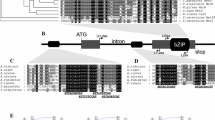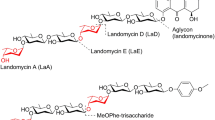Abstract
All of the binding sequences for MlcR, a transcriptional activator of ML-236B (compactin) biosynthetic genes in Penicillium citrinum, were identified by an in vitro gel-shift assay. All the identified sequences contain an asymmetric direct repeat comprised of conserved tetrad bases (A/T)CGG with a spacer sequence of high similarity; in particular, G at position 2 and T at position 3 in the spacer are well conserved. The first (A/T)CGG repeat was essential for MlcR-binding and MlcR could bind to this monomeric site, probably as a monomer. This binding feature might enable MlcR to tolerate the variation of the spacer length and compositions in vitro. From these data, we propose that the consensus binding motif for MlcR is an asymmetric direct repeat, 5′-(A/T)CGG-NGTN3–6-TCGG-3′.






Similar content being viewed by others
References
Abe Y, Ono C, Hosobuchi M, Yoshikawa H (2002a) Functional analysis of mlcR, a regulatory gene for ML-236B (compactin) biosynthesis in Penicillium citrinum. Mol Gen Genomics 268:352–361
Abe Y, Suzuki T, Ono C, Iwamoto K, Hosobuchi M, Yoshikawa H (2002b) Molecular cloning and characterization of an ML-236B (compactin) biosynthetic gene cluster in Penicillium citrinum. Mol Gen Genomics 267:636–646
Abe Y, Baba S, Suzuki S, Ono C, Iwamoto K, Hosobuchi M (2004) Molecular basis of ML-236B production in the high-producing mutant No. 41520 of Penicillium citrinum. J Gen Appl Microbiol 50:169–176
Baba S, Abe Y, Ono C, Hosobuchi M (2006) Targeted disruption of the genes, mlcR and ariB, which encode GAL4-type proteins in Penicillium citrinum. Biochim Biophys Acta 1759:410–416
Baba S, Nihira T, Hosobuchi M (2008) Identification of the specific sequence recognized by Penicillium citrinum MlcR, a GAL4-type transcriptional activator of ML-236B (compactin) biosynthetic genes. Fungal Genet Biol 45:1277–1283
Brown AG, Smale TC, King TJ, Hasenkamp R, Thompson RH (1976) Crystal and molecular structure of compactin, a new antifungal metabolite from Penicillium brevicompactum. J Chem Soc Perkin Trans 1:1165–1170
Ehrlich KC, Montalbano BG, Cary JW (1999) Binding of the C6-zinc cluster protein, AFLR, to the promoters of aflatoxin pathway biosynthesis gene in Aspergillus parasiticus. Gene 230:249–257
Endo A, Kuroda M, Tsujita M (1976) ML-236A, ML-236B, and ML-236C, new inhibitors of cholesterogenesis produced by Penicillium citrinum. J Antibiot 29:1346–1348
Felenbok B, Sealy-Lewis H (1994) In: Martinelli S, Kinghorn JR (eds) Genetics and physiology of Aspergillus nidulans, vol 29. Elsevier, Amsterdam, pp 141–179
Fernandes M, Keller NP, Adams TH (1998) Sequence-specific binding by Aspergillus nidulans AflR, a C6 zinc cluster protein regulating mycotoxin biosynthesis. Mol Microbiol 28:1355–1365
Fillinger S, Felenbok B (1996) A newly identified gene cluster in Aspergillus nidulans comprises five novel genes localized in the alc region that are controlled both by the specific transactivator AlcR and the general carbon-catabolite repressor CreA. Mol Microbiol 20:475–488
Giniger E, Varnum SM, Ptashne M (1985) Specific DNA binding of GAL4, a positive regulatory protein of yeast. Cell 40:767–774
Gómez D, Cubero B, Cecchetto G, Scazzocchio C (2002) PrnA, a Zn2Cys6 activator with a unique DNA recognition mode, requires inducer for in vivo binding. Mol Microbiol 44:585–597
Hosobuchi M, Shiori T, Ohyama J, Arai M, Iwado S, Yoshikawa H (1993) Production of ML-236B, an inhibitor of 3-hydroxy-3-metylglutaryl coenzyme A reductase, by Penicillium citrinum: improvements of strain and culture conditions. Biosci Biotech Biochem 57:1414–1419
King DA, Zhang L, Guarente L, Marmorstein R (1999) Structure of a HAP1-DNA complex reveals dramatically asymmetric DNA binding by a homodimeric protein. Nat Struct Biol 6:64–71
Lenouvel F, Nikolaev I, Felenbok B (1997) In vitro recognition of specific DNA targets by AlcR, a zinc binuclear cluster activator different from the other proteins of this class. J Biol Chem 272:15521–15526
Marmorstein R, Carey M, Ptashne M, Harrison SC (1992) DNA recognition by GAL4: structure of a protein-DNA complex. Nature 356:408–414
Nikolaev I, Lenouvel F, Felenbok B (1999) Unique DNA binding specificity of the binuclear zinc AlcR activator of the ethanol utilization pathway in Aspergillus nidulans. J Biol Chem 274:9795–9802
Panozzo C, Capuano V, Fillinger S, Felenbok B (1997) The zinc binuclear cluster activator AlcR is able to bind to single sites but requires multiple repeated sites for synergistic activation of the alcA gene in Aspergillus nidulans. J Biol Chem 272:22859–22865
Punt PJ, Strauss J, Smit R, Kinghorn JR, van den Hondel CA, Scazzocchio C (1995) The intergenic region between the divergently transcribed niiA and niaD genes of Aspergillus nidulans contains multiple NirA binding sites which act bidirectionally. Mol Cell Biol 15:5688–5699
Reece RJ, Ptashne M (1993) Determinants of binding-site specificity among yeast C6 zing cluster proteins. Science 261:909–911
Roy A, Exinger F, Losson R (1990) cis- and trans-acting regulatory elements of the yeast URA3 promoter. Mol Cell Biol 10:5257–5270
Schjerling P, Holmberg S (1996) Comparative amino acid sequence analysis of the C6 zinc cluster family of transcriptional regulators. Nucleic Acids Res 24:4599–4607
Siddiqui AH, Brandriss MC (1989) The Saccharomyces cerevisiae PUT3 activator protein associates with proline-specific upstream activation sequences. Mol Cell Biol 9:4706–4712
Strauss J, Muro-Pastor MI, Scazzocchio C (1998) The regulator of nitrate assimilation in ascomycetes is a dimer which binds a nonrepeated, asymmetrical sequence. Mol Cell Biol 18:1339–1348
Suárez T, de Queiroz MV, Oestreicher N, Scazzocchio C (1995) The sequence and binding specificity of UaY, the specific regulator of the purine utilization pathway in Aspergillus nidulans, suggest an evolutionary relationship with the PPR1 protein of Saccharomyces cerevisiae. EMBO J 14:1453–1467
Todd RB, Andrianopoulos A (1997) Evolution of a fungal regulatory gene family: the Zn(II)2Cys6 binuclear cluster DNA binding motif. Fungal Genet Biol 21:388–405
Todd RB, Andrianopoulos A, Davis MA, Hynes MJ (1998) FacB, the Aspergillus nidulans activator of acetate utilization genes, binds dissimilar DNA sequences. EMBO J 17:2042–2054
Zhang L, Guarente L (1994) The yeast activator HAP1—a GAL4 family member—binds DNA in a directly repeated orientation. Genes Dev 8:2110–2119
Zhang L, Guarente L (1996) The C6 zinc cluster dictates asymmetric binding by HAP1. EMBO J 15:4676–4681
Acknowledgments
We wish to thank Dr. A. Miyadera, Dr. M. Takahashi and Dr. Y. Abe for their encouragement and suggestions. We would also like to thank Dr. F. Matsuda and Ms. K. Ono for their technical advice and support in the gel-shift assay.
Author information
Authors and Affiliations
Corresponding author
Additional information
Communicated by H. Ronne.
Rights and permissions
About this article
Cite this article
Baba, S., Kinoshita, H., Hosobuchi, M. et al. MlcR, a zinc cluster activator protein, is able to bind to a single (A/T)CGG site of cognate asymmetric motifs in the ML-236B (compactin) biosynthetic gene cluster. Mol Genet Genomics 281, 627–634 (2009). https://doi.org/10.1007/s00438-009-0435-9
Received:
Accepted:
Published:
Issue Date:
DOI: https://doi.org/10.1007/s00438-009-0435-9




